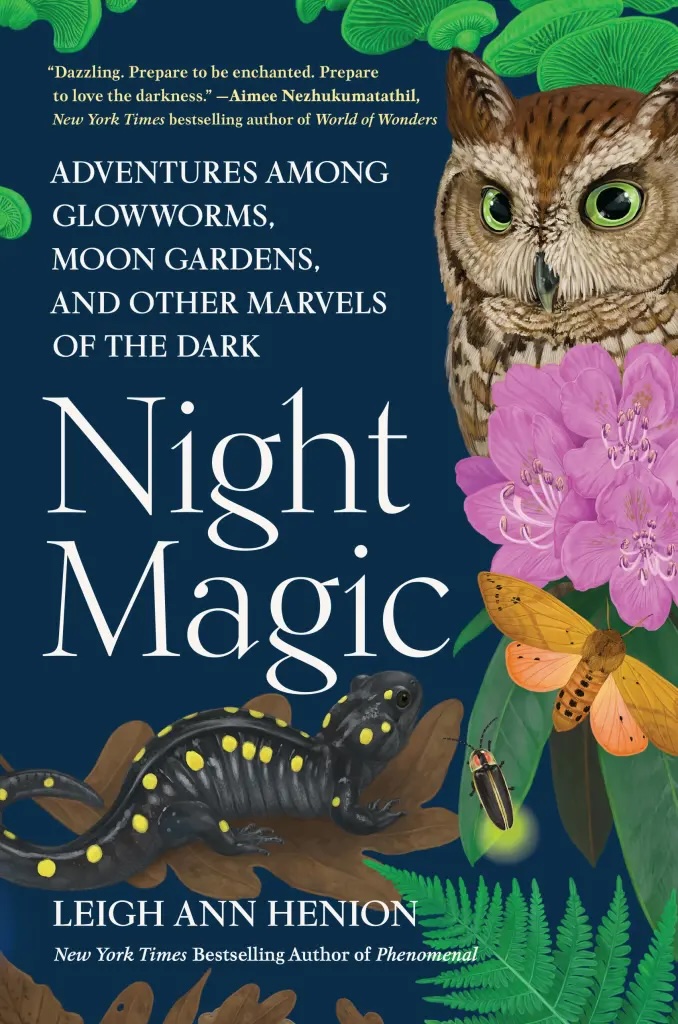Night Magic
Leigh Ann Henion
Algonquin Books, $30
I feel like I’ve been out all night. In my mind, I’ve been walking the mountains and meadows of the Appalachian region after dark. I’ve encountered spotted salamanders, synchronous and blue ghost fireflies, glowworms and different kinds of moths and bats. My guide has been Leigh Ann Henion, who seeks to restore night to its rightful place as a wonderland of nature and renewal in her latest book, Night Magic.
Henion pursues nighttime journeys as a balm, searching for respite from the near-constant illumination due to artificial light. She wonders, what’s life like in the dark? “Darkness is often presented as a void of doom rather than a force of nature that nourishes lives, including our own,” Henion writes. “This is the story of how I set out to re-center darkness by spending time with some of the diverse and awe-inspiring life-forms that are nurtured by it.”
Henion — an author who writes about the natural world, travel and other topics — takes readers to Tennessee, Ohio, Alabama and her home state of North Carolina. In the company of friends, her son, scientists and other night-curious strangers, she seeks the fauna, flora and fungi that thrive in darkness, sometimes searching in her own backyard.
The book moves through spring, summer and fall, each season focusing on a few different life-forms. In the spring, for example, she witnesses spotted salamanders, which live much of their lives in darkness. These black or dark-brown amphibians with cheery, yellow-orange spots spend most of their time below ground. The salamanders briefly emerge during spring nights to breed in ephemeral pools, areas fed by rain that dry out periodically.
Henion’s night excursions continue with appearances from glowworms, which are luminous fly larvae that shine blue; colorful moths, major pollinators that are experiencing troubling population declines; and foxfire, the catchall term for bioluminescent fungi glowing on forest floors. Mixed in among these encounters, Henion laments the ever-growing theft of natural darkness by artificial light in her mountain neighborhood and around the world (SN: 1/19/23). “At this point in history,” she writes, “a full third of human beings on this planet can no longer see the Milky Way from where they live.”
Henion encourages readers to tune in to the darkness around them. This may require patience because it can take the eyes several hours to become adapted to low light. And she unpacks the fears people — including herself — can have about darkness and the animals associated with it.
For example, when Henion gets the opportunity to help survey bat populations in Alabama, she recounts feeling unnerved by an encounter with a bat that dove at her. A student of one of the bat researchers at the event reassured Henion that the bat wasn’t ambushing her: “You’ve got to remember, bats are better fliers than Tom Cruise in Top Gun.” The bat was just having dinner — the bugs around Henion’s head, which were attracted to the carbon dioxide she exhaled.
Like bats, moths may be unfairly maligned in part for their connection to night, Henion writes. It’s thought that moths orient themselves with help from the constant angle of the moon and are flummoxed by artificial lights that bombard them from all directions (SN: 1/30/24). As a moth enthusiast tells Henion, “in that state of artificial-light disorientation, it feels like a moth’s attacking us,” when instead, the creature doesn’t know where to fly.
Though Henion refers to emerging research about artificial light’s effects on human health, I found myself wishing for more details. For instance, she writes in the preface that light pollution “has been shown to cause increased rates” of certain health conditions. But the research she cites in the bibliography describes associations between artificial light and different health harms. Association does not mean causation. Excessive light exposure after it becomes dark does seem to be a health risk, but I was left wondering how big of a risk and where the science currently stands.
That criticism doesn’t detract from the book’s enthusiastic and meaningful argument to preserve natural darkness and the ecosystems that rely on it, for the sake of the creatures, the plants and ourselves. Henion closes with what feels like a blessing and a call to action: “May we find our way back to natural darkness, or at least hold fast to the wilderness that still exists, so that we’ll be able to bear witness to night’s living riches.”
Buy Night Magic from Bookshop.org. Science News is a Bookshop.org affiliate and will earn a commission on purchases made from links in this article.


